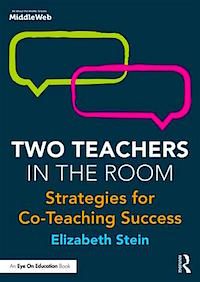Keep Gratitude at the Center of Co-Teaching
A MiddleWeb Blog
 Are you ready to consider a surefire way to empower your co-teaching mindset for the rest of the year? Not just your personal mindset – but also the perspective of your co-teacher?
Are you ready to consider a surefire way to empower your co-teaching mindset for the rest of the year? Not just your personal mindset – but also the perspective of your co-teacher?
Does it sound too good to be true? It’s not! All it takes is for you to tap into your grateful side. We all have one! This recent article from the Daily Health Post website shares research to support that people who intentionally practice feelings of gratitude are just plain happier. So, co-teaching colleagues from around the nation, let’s have some fun with this!
If you are part of a positive co-teaching relationship, read on. You will be validated and further empowered to continue your enjoyable co-teaching path. If you are feeling the co-teaching blues, this post is exactly what you need to redirect and rewire your co-teaching experiences. Read on!
The power of gratitude
It is part of the tradition of the winter holiday season to think about what we are grateful for. So why not mindfully consider how this powerful emotion of gratitude might empower you and your co-teacher throughout the school year?
The emotion of gratitude is believed to improve a person’s mood, sleep, and relationships with others. As you learned from clicking on the links above, research reveals gratitude supports the actual rewiring of the brain and places an individual in a happier state of being. Imagine that!
We can shift the way we experience co-teaching (and life in general!) simply by considering gratitude as a powerful antidote to the challenges and joys of co-teaching.
Transforming challenges with gratitude
As I collaborate with co-teachers around the nation, common challenges continue to emerge. You know the familiar barriers I am talking about. They include:
- Not enough (or any!) co-planning time.
- Uncooperative (and sometimes disrespectful) co-teaching relationships.
- Not enough time in the day or class period to meet the needs of diverse learners.
So, here’s my suggestion. Look at each challenge and bring gratitude to it. That may sound pointless to you, but how will you know until you really try it? It may be easier to complain, but it’s also an energy drain, and even a time-waster. So why not try feeling grateful?
Let’s look at those three barriers for a few moments.
-
Not enough, or any, co-planning time?
It’s time to look at the time you DO have. Look for those class embedded bits of time when you and your co-teacher may collaborate and plan “in the moment.” Also, consider the power of technology – and be willing to co-plan asynchronously through texting, email or Google Docs (we live in a world where you don’t always have to be immediately present to communicate). Or jump on a Google Hangout or Skype session to plan together during your regular planning time at home.
Be grateful for all these options. Be grateful for the fact that as long as you and your co-teacher are flexible, you have class time to model for your future adult workers how to communicate effectively with colleagues – in this case, two teachers in the room.
-
What if there’s at least one co-teacher in the room who is not having it?
One co-teacher is perhaps territorial, uncooperative, and seems standoffish. It happens. It will take great flexibility of mind for the other co-teacher to weave in feelings of gratitude for what may easily become a constant cycle of exhaustion from daily discouragement. However, when gratitude is brought to this situation, the frustrated co-teacher can consider how the situation guides them to speak UP and advocate for their co-teaching responsibility.
Put another way: if you are working with a seemingly uncooperative co-teacher, meet the challenge with gratitude for the opportunity to work on your interpersonal skills. Consider what YOU can do to respect your co-teacher – while never giving up on communicating your professional responsibility to do what is right for all the learners in the room (including your co-teacher – and yourself).
-
There just never seems to be enough time.
Why is that? I dare say, co-teachers are often wasting time saying there is not enough of it. Just stop it! Be grateful for the time you DO have. Become keenly aware of what you ARE doing. And reflect on the ways you can do more (or less!) in the time you do have.
For all three challenges mentioned, consider some exercises that you and your co-teacher might do to embed gratitude as part of the solution to any challenge. Also, is there a challenge not mentioned here? Share it in the comments section below – let’s shift it to feeling grateful together!
Try these gratitude exercises
✻ Take this gratitude questionnaire to better understand your general stance toward gratitude. Then turn the conversation toward co-teaching and discuss with your colleague how to create a co-gratitude experience.

✻ Look for what is going well. There is always something! Notice it. Acknowledge it. Be grateful for it. And enjoy some time speaking with your co-teacher about what you are thinking. Aim to share between three to five things each week that you feel grateful for – and let your co-teacher know.
✻ Enjoy the benefits of co-teaching. I was recently in a conversation with a group of co-teachers, and we were listing all the ways each day that co-teaching can be a professional learning opportunity. Now multiply that by five, and you have the possibility of engaging in some strong collaborative learning that is embedded in your daily routine each week.
If this seems like a lot of change, find a place to begin – to just do it. Suggestion: make time to check in with one another by sharing one personal and one professional communication at least three times each week.
Always remember – co-teaching is built-in, job-embedded, potentially powerful professional learning! There is so much to learn from and with one another. Talk about being grateful…the possibilities are endless!




































Thank you for these tips. It is always good to be grateful for what you have.